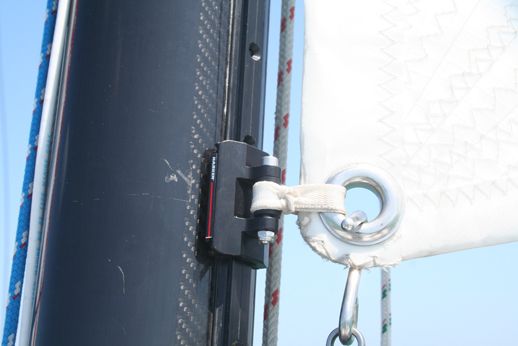
One of the key improvements made to the mainsail featured in the August 2011 article on choosing a mainsail was the addition of the Tides Marine Sail Track, a slippery track made of ultra-high molecular weight plastic that can be installed onto an existing mast track.
Another option is to install one of the various rolling, low-friction batten slides on the market. Harken, Rutgerson, Selden, and others make slides designed to handle the high loads imposed by a roachy, full-batten mainsail on the mast, but these are generally more expensive than the Tides Marine option.
One of the difficult challenges faced by these slides are the side loads imposed when the sail is not feathered into the wind. In the event that the sail needs to be dropped (or raised) off the wind, the unequal loading on the batten cars can cause friction on one side or the other of the cars.
Harkens bearing slides pictured here are one approach to solving the friction problem. While some boat manufacturers have had good results with these slides on larger models, the trend toward trailerable, user-friendly boats presents a problem for these types of bearing slides. As we found in our recent boat tests of the Presto 30 and the Norseboat 21.5, the Harken slides are problematic for smaller boats that remove their sails for trailering.
According to the makers of the Norseboat 21.5 and the Presto 30, the retaining wire that keeps the bearings in place is thin and tends to bend, and once bent, they are nearly impossible to get back into shape. On the Presto 30 we tested, the owner had given up chasing bearings around his deck and was using the slides without the bearings, making raising the sail a bear-so to speak.
We spoke with Harken about this, and they said they were aware of the problem with the retaining wire, but that because of the small size of the slides, there is no easy solution. Harken says there is very little demand for bearing slides in this size. The problem does not exist in the bigger sizes, according to Harken. If you don’t remove your sail for trailering, you may never run into the problem. The Presto and the Norseboat, both of which tout their relative ease of trailering, are opting for Strong Tracks in their future boats.




































